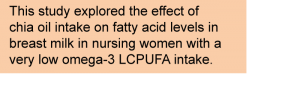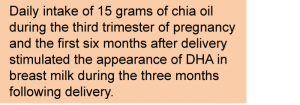Enhanced Production of Breast Milk DHA during Chia Oil Intake
This article at a glance
- A randomized controlled intervention trial has addressed the effect of chia oil intake during pregnancy and nursing on breast milk fatty acid composition in healthy women.
- In addition to increased levels of alpha-linolenic acid, a marked elevation in docosahexaenoic acid (DHA) in breast milk is observed during the first three months in nursing women taking chia oil.
- The study indicates that chia oil consumption can promote additional accumulation of DHA into breast milk, a potentially useful application to support dietary omega-3 LCPUFA needs by infants in conditions where maternal DHA consumption is low or absent.
- Further studies are necessary to confirm that this mechanism is functional in nursing women beyond the group of women studied here.
Breast-feeding is very important for the developing child for many reasons, one major reason being that breast milk provides many if not all of the nutrients that a growing infant needs, including long-chain polyunsaturated fatty acids (LCPUFA) that contribute to the development of the nervous system. The level of docosahexaenoic acid (DHA) in breast milk is determined by the DHA status of the mother. The fatty acid composition of blood cells and breast milk is a reflection of the dietary fatty acid intake during pregnancy and nursing. To attain a sufficient level of DHA in breast milk that supports adequate biomagnification (active accretion of DHA by the infant from breast milk), it has been estimated that a mother needs to carry approximately 6% of fatty acids in red blood cell membranes as DHA throughout pregnancy. However, significant variability in the transfer of DHA from the mother to the fetus during pregnancy is also recognized. Breast milk DHA is believed to be largely transported from a mother’s depot tissues to the mammary glands that produce breast milk.
 Alpha-linolenic acid (ALA) is the precursor for the biosynthesis of the longer chain omega-3 PUFAs in mammals. The efficiency (or fractional conversion) whereby dietary ALA is transformed in adults into DHA is considered very low, although in women it is somewhat higher than in men. A diet low in DHA is inadequate to satisfy the physiological requirements for DHA of some tissues in the body, particularly during specific periods in life when requirements are high such as during fetal and infant growth. Provision of ALA to a mother’s diet will lead to the formation of EPA, as measurable in red blood cell membranes, but not to significant increases in DHA. EPA is not present in human breast milk at substantial levels, and the requirement for it in infant development is less clear than for DHA. Hence, it is widely considered that during pregnancy ALA may not contribute substantially to breast milk DHA levels, and direct intake of DHA by pregnant and nursing mothers is widely recommended to increase DHA availability during nursing. However, it is possible that under conditions of very low or no DHA intake, augmented ALA to DHA conversion may support DHA production, provided sufficient ALA is ingested. An interesting question that is not completely answered is to what extent can ALA compensate for a lack of DHA in a pregnant or nursing mother’s diet?
Alpha-linolenic acid (ALA) is the precursor for the biosynthesis of the longer chain omega-3 PUFAs in mammals. The efficiency (or fractional conversion) whereby dietary ALA is transformed in adults into DHA is considered very low, although in women it is somewhat higher than in men. A diet low in DHA is inadequate to satisfy the physiological requirements for DHA of some tissues in the body, particularly during specific periods in life when requirements are high such as during fetal and infant growth. Provision of ALA to a mother’s diet will lead to the formation of EPA, as measurable in red blood cell membranes, but not to significant increases in DHA. EPA is not present in human breast milk at substantial levels, and the requirement for it in infant development is less clear than for DHA. Hence, it is widely considered that during pregnancy ALA may not contribute substantially to breast milk DHA levels, and direct intake of DHA by pregnant and nursing mothers is widely recommended to increase DHA availability during nursing. However, it is possible that under conditions of very low or no DHA intake, augmented ALA to DHA conversion may support DHA production, provided sufficient ALA is ingested. An interesting question that is not completely answered is to what extent can ALA compensate for a lack of DHA in a pregnant or nursing mother’s diet?
Chia oil is a plant oil extracted from the seeds of the plant Salvia hispanica, native to Central America, and now cultivated in many parts of the Americas. Among plant oils, chia oil has a very high level of ALA (60-65% of fatty acids as triglyceride). To address the issue whether chia oil consumption during pregnancy and after delivery can support adequate breast milk DHA levels, Valenzuela and colleagues carried out a controlled intervention study in pregnant women. The study was performed at the Department of Nutrition, the Lipid Center at the Institute of Nutrition and Food Technology, and the Obstetrics and Gynecology department at the Clinical Hospital, all at the University of Chile, Santiago, Chile.
Forty pregnant women were randomly assigned to either a control group (n=21) or to a second group that received 16 ml chia oil per day (4 tableteaspoons of oil containing 10.1 g of ALA). The control group (n=19) took the same volume of a sunflower/soybean oil (80:20 v/v). The women were instructed to replace the oil they usually used at home with the test oil, mainly in salads eaten at lunch or dinner. The oils were taken from the sixth month of pregnancy onwards, until the sixth month of nursing. The chia oil was a cold-pressed chia seed oil. A dietary record was maintained to follow the daily consumption of test oil.
All women were of Hispanic origin, between 22 and 35 years old, and had had prior successful nursing (1 to 4 children). Women with an illness that could affect their pregnancy, or those taking fatty acid supplements, were excluded from participating in this study. The women that were studied were mostly of medium socio-economic status, mean age 29 years, and a pre-pregnancy body mass index that was normal (borderline to overweight). At study onset, the pregnant women were clinically evaluated, with measurement of weight and height. Dietary intake was evaluated using a food-frequency questionnaire combined with a photographic display of Chilean foods, at study initiation (six months of pregnancy), one week after delivery, and six months after delivery. A dedicated software program was used to calculate the energy and nutrient intake, using a food composition database. The fatty acid composition of red blood cell membrane phospholipids was measured by gas-liquid chromatography, from frozen erythrocyte samples collected at the study onset, immediately after delivery, and six months after delivery. The fatty acid content of the phospholipid fraction in breast milk was also determined. Breast milk samples (5 ml) were collected by the mothers themselves during breast feeding, each month during the six months after delivery.
 There were no significant differences in anthropometric measures between women in the chia and control groups, no differences in gestational length, or gender, birthweight and height of their babies. Beyond changes in PUFA intake, there were no significant changes in the energy and composition of the diet ingested by mothers during pregnancy, at delivery, and while nursing, except for a small decrease in total energy and carbohydrate intake in the control group at six months of nursing compared to six months of pregnancy. Total omega-6 LCPUFA and linoleic acid intake, as well as the omega-6 to omega-3 intake ratio, were significantly lower in mothers in the chia oil group at delivery and at six months of nursing. As intended, total omega-3 LCPUFA and ALA intake were significantly increased during chia oil consumption, by a factor six to eightfold, compared to mothers in the control group. These changes in fatty acid intake at delivery and six months of nursing were mirrored by the fatty acid composition of red blood cell membranes. Levels of EPA in red blood cell membranes, but not of DHA, were significantly increased (2.7 fold at delivery and 2.5 fold at six months nursing). Basal dietary DHA intake in these women was very low and ranged from 0.02 ± 0.03 to 0.1 ± 0.1 g/ day throughout the study period.
There were no significant differences in anthropometric measures between women in the chia and control groups, no differences in gestational length, or gender, birthweight and height of their babies. Beyond changes in PUFA intake, there were no significant changes in the energy and composition of the diet ingested by mothers during pregnancy, at delivery, and while nursing, except for a small decrease in total energy and carbohydrate intake in the control group at six months of nursing compared to six months of pregnancy. Total omega-6 LCPUFA and linoleic acid intake, as well as the omega-6 to omega-3 intake ratio, were significantly lower in mothers in the chia oil group at delivery and at six months of nursing. As intended, total omega-3 LCPUFA and ALA intake were significantly increased during chia oil consumption, by a factor six to eightfold, compared to mothers in the control group. These changes in fatty acid intake at delivery and six months of nursing were mirrored by the fatty acid composition of red blood cell membranes. Levels of EPA in red blood cell membranes, but not of DHA, were significantly increased (2.7 fold at delivery and 2.5 fold at six months nursing). Basal dietary DHA intake in these women was very low and ranged from 0.02 ± 0.03 to 0.1 ± 0.1 g/ day throughout the study period.
A comparison of the fatty acid content of breast milk produced each month after delivery showed no changes in saturated fatty acids, mono-unsaturated fatty acids, or total PUFA. Throughout the 6-month nursing period total omega-6 PUFA levels in maternal milk were significantly lower, and total omega-3 PUFA levels were approximately twice as high in the chia oil group compared to controls. The omega-6 to omega-3 PUFA ratio in breast milk was about three-fold lower in the chia group during the six month nursing period. Breast milk linoleic acid was lower in the chia oil group, but arachidonic acid levels were similar in the groups. ALA levels were higher throughout the nursing period, and the already low EPA levels remained similar between the chia oil and control group. Remarkably, during the first three months after delivery DHA was significantly elevated in the breast milk of the mothers that took chia oil. DHA levels were four times higher than in controls during the first two months post-partum, decreasing to three-fold higher in the third month. DHA levels in maternal milk returned to the levels of the control group four months after birth, even with chia oil supplementation still ongoing.
 In summary, chia oil supplementation during pregnancy and nursing to healthy mothers led to a marked increase in the DHA content of breast milk during the first three months of nursing. During the course of the study, chia oil supplementation changed the relative dietary intake of linoleic acid to ALA from a ratio of 15 to nearly 1. The biotransformation of ALA derived from chia oil intake to downstream omega-3 LCPUFA was reflected in the composition of the red blood cell membrane phospholipids, with an increase in EPA concentration. Although a marked increase of DHA was found in breast milk, there was no increase in red blood cell DHA levels. DHA formation from the dietary intake of another ALA-rich plant seed oil, sacha inchi oil, has been shown to increase the levels of DHA in plasma. DHA levels in red blood cells during chia oil consumption were held to a similar basal level observed in the control group, suggesting a dynamic regulation of DHA content in maternal milk permitting an elevated level during just the first three months of a nursing infant. This observation suggests that regulation of DHA formation from ALA is taking place during pregnancy in a way that is even more intricate than previously anticipated.
In summary, chia oil supplementation during pregnancy and nursing to healthy mothers led to a marked increase in the DHA content of breast milk during the first three months of nursing. During the course of the study, chia oil supplementation changed the relative dietary intake of linoleic acid to ALA from a ratio of 15 to nearly 1. The biotransformation of ALA derived from chia oil intake to downstream omega-3 LCPUFA was reflected in the composition of the red blood cell membrane phospholipids, with an increase in EPA concentration. Although a marked increase of DHA was found in breast milk, there was no increase in red blood cell DHA levels. DHA formation from the dietary intake of another ALA-rich plant seed oil, sacha inchi oil, has been shown to increase the levels of DHA in plasma. DHA levels in red blood cells during chia oil consumption were held to a similar basal level observed in the control group, suggesting a dynamic regulation of DHA content in maternal milk permitting an elevated level during just the first three months of a nursing infant. This observation suggests that regulation of DHA formation from ALA is taking place during pregnancy in a way that is even more intricate than previously anticipated.
This study was carried out in mothers of Hispanic origin in Chile, and interesting new studies await to establish whether chia oil consumption may support increased DHA levels in the maternal milk in mothers of different regional and/or ethnic origin. The concommitant amount of dietary linoleic acid is an important factor to take into account, since lower dietary intake of linoleic acid resulting from a change in dietary oil use, as observed in the present study, will allow more efficient conversion of ALA to longer chain downstream metabolites, including DHA. This study has exposed chia oil as a potentially nutritionally valuable seed oil during pregnancy and nursing. Understanding how chia oil consumption augments maternal milk DHA levels may provide further insight into how the body regulates the delivery of adequate amounts of DHA to an infant.
Valenzuela R, Bascunan K, Chamorro R, Barrera C, Sandoval J, Puigrredon C, Parraguez G, Orellana P, Gonzalez V, Valenzuela A. Modification of docosahexaenoic acid composition of milk from nursing women who received alpha-linolenic acid from chia oil during gestation and nursing. Nutrients 2015;7(8):6405-6424. [PubMed]
Worth Noting
Burdge GC, Calder PC. Conversion of alpha-linolenic acid to longer-chain polyunsaturated fatty acids in human adults. Reprod. Nutr. Dev. 2005;45(5):581-597. [PubMed]
Chan JK, McDonald BE, Gerrard JM, Bruce VM, Weaver BJ, Holub BJ. Effect of dietary alpha-linolenic acid and its ratio to linoleic acid on platelet and plasma fatty acids and thrombogenesis. Lipids 1993;28(9):811-817. [PubMed]
Gonzales GF, Gonzales C, Villegas L. Exposure of fatty acids after a single oral administration of sacha inchi (Plukenetia volubilis L.) and sunflower oil in human adult subjects. Toxicol. Mech. Methods 2014;24(1):60-69. [PubMed]
Luxwolda MF, Kuipers RS, Sango WS, Kwesigabo G, Dijck-Brouwer DA, Muskiet FA. A maternal erythrocyte DHA content of approximately 6 g% is the DHA status at which intrauterine DHA biomagnifications turns into bioattenuation and postnatal infant DHA equilibrium is reached. Eur. J. Nutr. 2012;51(6):665-675. [PubMed]
Makrides M. Is there a dietary requirement for DHA in pregnancy? Prostaglandins Leukot. Essent. Fatty Acids 2009;81(2-3):171-174. [PubMed]
Mammary gland: http://www.courseweb.uottawa.ca/medicine-histology/english/Reproduction/mammary/mammary_repro.htm
Ruiz-Gutierrez V, Cert A, Rios JJ. Determination of phospholipid fatty acid and triacylglycerol composition of rat caecal mucosa. J. Chromatogr. 1992;575(1):1-6. [PubMed]
Scholtz SA, Colombo J, Carlson SE. Clinical overview of effects of dietary long-chain polyunsaturated fatty acids during the perinatal period. Nestle Nutr. Inst. Workshop Ser. 2013;77:145-154. [PubMed]
Uhl O, Hellmuth C, Demmelmair H, Zhou SJ, Makrides M, Prosser C, Lowry D, Gibson RA, Koletzko B. Dietary effects on plasma glycerophospholipids. J. Pediatr. Gastroenterol. Nutr. 2015;61(3):367-372. [PubMed]

